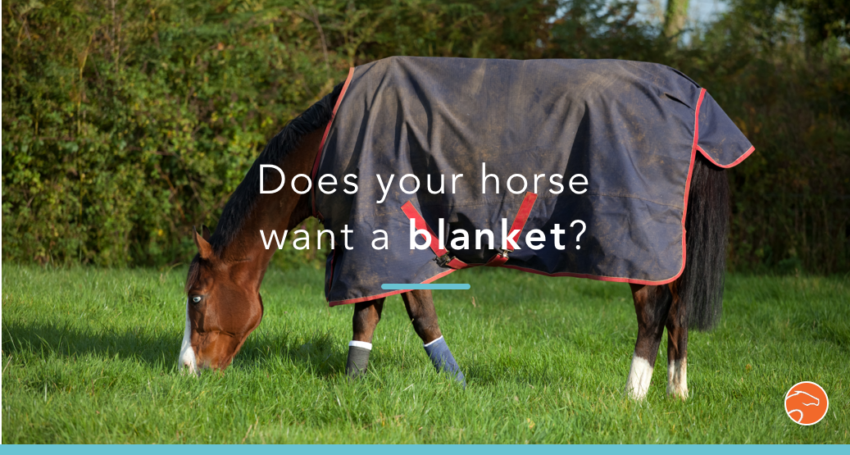
How to teach your horses to say if they want a blanket in 3 steps
Winter is here and with it the eternal question: “Do I put a blanket on my horse?”. In fact, the best one to inform you would certainly be your horse themselves, you would just need to find a way to make them speak. Well, this is what Norwegian researchers have done. We explain you how to do the same in 3 steps !
Table des matières
Let’s start with a short presentation of the study
It was made in 2013 in Norway on 22 horses. The aim was to show that horses can learn to communicate with humans using symbols. And to do this, they chose a situation that could be useful to all of us: blankets.
The study began with a learning period during which the horses were able to associate a gesture with each symbol:
- Horizontal line = put the blanket on
- No symbol = do nothing
- Vertical line = remove the blanket

How did the horses learn to ask for a blanket?
The horses in the study were trained by a professional trainer and his two assistants. All of them had several years of experience in the clicker method. Please be patient (and prepare a lot of carrots) if you want to try it yourself.
💡 Learn more : 10 Horsemanship Ethology Principles All Riders Should Know
The learning process followed 3 main steps:
1. The horse learns to touch the different symbols
At this stage, the horse must learn to touch the sign with its nose when asked to approach it. They must not be disturbed by the fact that the signs change places. When the horses touche the panel, they get a piece of carrot as a reward.
2. The horse learns the difference between the different symbols
Now the horse must understand the difference between the symbols. To do this, at the beginning only one symbol is proposed to the horse. For example: “remove the cover” if they have one or the opposite. The horse is asked to touch, is rewarded and then the action is performed.
In a second step, the symbols “put a blanket on” and “remove the blanket” are proposed. This time the horses are only rewarded if they choose the sign that corresponds to their situation. “Put a blanket on” if they don’t have one and vice versa. At the beginning you can help them by placing the good sign closer to them than the wrong one, then mixing them up afterwards.
For the rest, the horses must understand that their choice has a consequence on their own comfort. For this you can make a “warm test” by putting on a blanket that is too warm and then offer them the signs. On the other hand, you can make a “cold test” by putting them outside in bad weather without a blanket. Each time, reward them if they touch the right symbol.
The horse chooses the symbol freely 👈🏼
You can now introduce the 3rd symbol. Reward them each time they touch it, but do not put on/take off the blanket. However, do not reward them if they touch “put a blanket on” when they already have one, just ignore them.
You can then check that your horse chooses the symbol according to their comfort. To do so, you can repeat the warm and cold tests presented in step 2 by proposing them only the 2 significant symbols. For example if they touch “put a blanket on” after a cold test, it’s a win, they have understood ! Finally repeat the exercise several times to check that it is not just luck 🍀
Some details on the study in question
Here I have described the learning method in broad outline. If you want more details you can read the publication of the study. The references are in the end of the article.
In this study, the horses took approximately the same amount of time to complete their training, 14 days. However, they behaved differently. For example, those that learned fast at the beginning wasted time exploring other solutions to get more carrots (nibbling on the signs for example). On the contrary, those who learned more slowly were more consistent. A 3-year-old seemed to particularly appreciate having his blanket removed and put back on so when he was just asking for it all the time. He needed more time to understand the implication on his thermal comfort.
So how does that work out?

The researchers noted that indeed, all 22 horses had asked not to have a blanket when the weather was nice (20°C to 23°C) so to remove it if they had one or not to change it otherwise.
Know more about this : How to React if Your Horse Sweats and Is Dehydrated
Conversely, the researchers did a test during two days when it rained (5°C to 9°C). This time 20 horses asked for a blanket! The two cold-resistant horses were again tested in negative temperatures and there they asked for a blanket (finally!).
Horses can express their desires through symbols. Okay, there were only 22 horses, but it’s a start. Moreover, the method can be criticized since the horses couldn’t say they wanted an extra blanket if they already had one. It’s up to you to improve their protocol and let your horse speak
Alice MARTINEZ
R&D engineer at Equisense
Bibliographie :
[1] Mejdell, C. M., Buvik, T., Jørgensen, G. H. M., & Bøe, K. E. (2016). Horses can learn to use symbols to communicate their preferences. Applied Animal Behaviour Science, 184, 66–73. https://doi.org/10.1016/j.applanim.2016.07.014